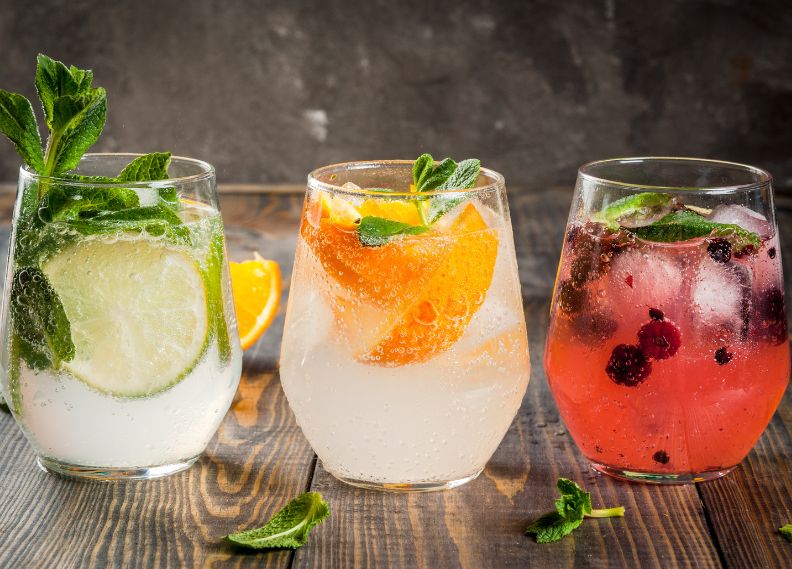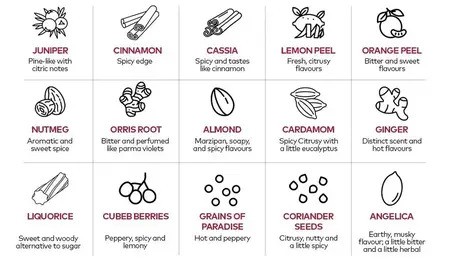
What Are Botanicals?
Behind every perfect gin cocktail lies a secret garden of botanicals. Explore the unique qualities of different botanicals, pick up essential tips and try our serves designed to complement each gin's unique aromas and flavors.
Estimated reading time: 4 Minutes
How are Botanicals used in Gin?

How are Botanicals used in Gin?
Gin is produced by combining a neutral grain spirit with juniper berries and other botanical ingredients such as fruits, seeds and spices.
The aromatic compounds found in botanicals are absorbed when immersed in the spirit or by the vapor as it passes through during the distillation process. The Master Distiller meticulously selects the exact combination of botanicals to produce a perfect balance of flavors unique to their gin.
The Importance of Juniper
Juniper berries are the core botanical found in all gins and, by law, they must be the principal flavor to classify a spirit as gin. They are fragrant and spicy with tasting notes of lavender and camphene.
There are hundreds of additional botanicals used to produce gin. Here are a few of the most common:

Four Tantalizing Gin Serves
Understanding your chosen gin's different botanicals and flavors helps create better, more balanced serves and bring freedom to experiment with ingredients and garnishes.
Here are four gin serves highlighting the botanicals in the world-famous Tanqueray gin.
Tanqueray Tonic with Lemon and Rosemary

Tanqueray Tonic with Lemon and Rosemary
Gin: Tanqueray London Dry
Botanicals: Juniper, coriander, angelica root and licorice.
Flavor: Distinctive piney juniper and faint lemon zest.
Tasting notes: The combination of lemon and rosemary perfectly complements the notes of licorice and lemon zest.
Tanqueray No. Ten Martini

Tanqueray No. Ten Martini
Gin: Tanqueray No. Ten
Botanicals: Tanqueray's four base botanicals, juniper, coriander, angelica root and licorice, together with whole fresh citrus and chamomile.
Flavor: Citrus and zesty notes.
Tasting notes: The pink grapefruit garnish draws out the subtle hints of citrus and chamomile.
Tanqueray Flor de Sevilla Negroni

Tanqueray Flor de Sevilla Negroni
Botanicals: Tanqueray's four base botanicals; juniper, coriander, angelica root and licorice, together with bittersweet Seville oranges and orange blossom flavors.
Flavor: Tangy and sweet profile.
Tasting notes: A sumptuous evening aperitif, highlighting tangerine and hints of juniper and coriander in the gin.
Tanqueray Rangpur and Tonic

Tanqueray Rangpur and Tonic
Gin: Tanqueray Rangpur
Botanicals: Tanqueray's four base botanicals; juniper, coriander, angelica root and licorice, with Rangpur lime (an exotic citrus fruit originating from India), ginger and bay leaves.
Flavor: A light, easy-drinking gin with a sharp citrus twist.
Perfect serve: Tanqueray Rangpur and Tonic.
Tasting notes: A distinct citrus flavor best paired with premium tonic water and a generous wedge of lime.
Key Takeaways
Botanicals, The Heart of Gin: Botanicals are the carefully chosen flavorful ingredients that define each gin's unique taste.
Juniper, The Essential Ingredient: Juniper berries are the core botanical in all gins and are legally required to be the dominant flavor.
Common Botanicals: While juniper is the star, there's a wide array of other botanicals used in gin production, including coriander seeds, nutmeg, orange peel, cinnamon and licorice.
Crafting Gin Cocktails: Understanding botanicals helps to create well-balanced cocktails and experiment with various ingredients and garnishes that highlight the gin's botanical essence.
Mixing with Tanqueray: Tanqueray's range of gins, including London Dry, Tanqueray No. Ten, Tanqueray Flor de Sevilla, and Tanqueray Rangpur offer the perfect base for botanical cocktails.
Armed with the knowledge of botanicals and their unique qualities, as well as the versatility, quality, and depth of Tanqueray, we can craft concoctions that pay homage to the botanicals' diverse nature and elevate the overall guest experience.
Related content

The Perfect Gin & Tonic
Tristan Stephenson provides his top tips for creating the perfect version of a bartender’s favorite drink, the gin & tonic.
Gin 101 With WSET: Gin Tasting and Cocktail Making
Discover all-things-gin with Lidiyanah Keller, Head Bartender at Singapore bar Atlas, no.16 in the World’s 50 Best Bars 2022, and Denaya Jones-Reid, a Wine and Spirit Education Trust Association (WSET) Educator.
Gin: History and Production
Explore the fascinating world of gin, with its rich history, meticulous craft, diverse botanical blends, and iconic cocktails.
